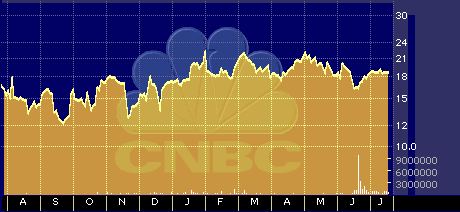
Mediacom IPO Makes Modest Debut
Mediacom IPO Makes Modest Debut
by Hal Plotkin
Silicon Valley Correspondent
Mediacom Communications Corp.’s {MCCC} initial public offering could set the stage for respectable gains, even though it has gotten only a modest start.
Late Thursday, the company’s 20 million share offering priced at 19 a share, at the top of its stated range of 16 to 19.
So far, Friday, the stock is up just slightly, after opening at 20 a share.

Mediacom Post-IPO Stock-Performance Chart
“They could be an interesting company to watch,” says Lisa Pierce, director of telecommunications services analysis at Giga Information Group, based in San Jose, Calif.
Betting on Mediacom is another way for investors to play the cable broadband telecom revolution.
Mediacom, based in Middletown, N.Y., owns the cable that passes through about 1.1 million homes across the nation and serves about 740,000 basic subscribers, mostly in non-metropolitan markets. The company is in the process of upgrading facilities to support broadband digital services, which are already available to more than 200,000 Mediacom subscribers.
In a nod to reality, Mediacom changed the anticipated opening price range of its shares two weeks ago to 16 to 19 from 15 to 20.
The move acknowledges that investors have been pretty lukewarm on cable stocks lately.
Charter Communications Inc. {CHTR}, for example, the nation’s fourth-largest cable operator, went public on Nov. 8 at $19 a share. The stock has bounced around a little since then but remains close to its offering price.
Stock Chart
Charter Communications Post-IPO Stock-Performance Chart
Analysts say there are several reasons investors have mostly overlooked cable stocks in their stampede to play the broadband telecom sector.
“Many cable companies like Charter carry a lot of debt,” says Bruce Kasral, senior analyst at Forrester Research, based in Cambridge, Mass. “It doesn’t look that great on the balance sheet when you know you have to pay it back.”
Late last year, for example, Charter, which is owned by Microsoft Corp. {MSFT} cofounder Paul Allen, announced plans to sell $900 million in junk bonds, with proceeds going toward repaying existing debt.
Even so, analysts say pure-play cable companies remain one of the best broadband bets around. Cable, they say, forms one of the strongest legs of a future telecom delivery system that includes wireless and hard-wired technologies offered by the cable industry’s arch rival, telephone companies, such as digital subscriber lines (DSL).
“We’re projecting four times as many consumers will be using cable modems vs. DSL by 2003,” Pierce says. “Cable has a very high viability. We’re starting to see cable users disconnecting from their local phone companies. That is obviously what the cable operators want to see.”
Cable-modem service currently has a commanding lead in the race to bring high-speed Internet access to U.S. homes. An estimated 1.3 million U.S. homes had high-speed cable access by year-end 1999, about five times more than the number of DSL subscribers, according to International Data Corp., based in San Jose, Calif. Wireless operators, by contrast, have yet to make serious inroads into the high-speed Internet-access market.
“Because of the pent-up demand for high-speed Internet-access services, the market for cable-modem services will continue to exhibit strong growth through 2000,” wrote Amy Harris, an analyst at IDC, in a recent research report. “However, after 2000, cable-modem services will face impending competition from other high-speed technologies — particularly DSL. The success or failure of DSL network upgrades, marketing and service delivery will have significant impact on the cable modem market, and vice versa.”
“The next few years are going to be very dicey,” Pierce says. “It’s going to come down to which incumbent carriers do the best job of consumer service.”
Consumer surveys show that high-speed Internet-access users are generally reluctant to switch providers if they are getting good service at competitive prices. That gives cable companies an advantage because of their larger and rapidly growing installed base of high-speed Internet-access customers. It is, however, an advantage that can also be quickly squandered.
Patti A. Reali, senior analyst at Dataquest, based in San Jose, Calif., says Mediacom’s competitive prospects are aided by the fact the company has sizable market penetration in rural areas that won’t be easily served by phone companies offering DSL. “There’s less competition in some of those rural markets, so they may be able to charge a premium,” she says.
Looking forward, Reali notes that major cable firms, such as Charter, Cox Communications Inc. {COX} and Time Warner Inc. {TWX}, have been paying somewhere north of about $4,000 per subscriber in the most-recent acquisitions and consolidations in the industry. That would value Mediacom’s assets at around $3 billion, a number investors should keep in mind when looking at the company’s post-IPO market capitalization. A takeover or buyout of the company might well be in the cards, particularly if the market cap languishes below the company’s fair-market value.
“They sound like an acquisition target to me,” Kasral says. “I think it’s quite possible that what we’ll eventually get is possibly three or four major cable carriers, and the rest will be really minor.” Kasral says Mediacom’s installed base of customers will likely attract the attention of another, larger competitor before very long.
“Overall, I’d rather be a cable company today,” Kasral says. “Super, super, long term, I’d rather be a wireless company. But for the foreseeable future, the cable operators have some advantages. The key thing is what they do with their data play, their telephony play. That’s what you should really pay attention to. But it would be a mistake to count them out, particularly over the next few years.”
Mediacom posted a loss of $23.6 million on $74.1 million in revenue for the six months ended Sept. 30, as compared with a loss of $18.4 million on revenue of $60.06 million a year earlier.


